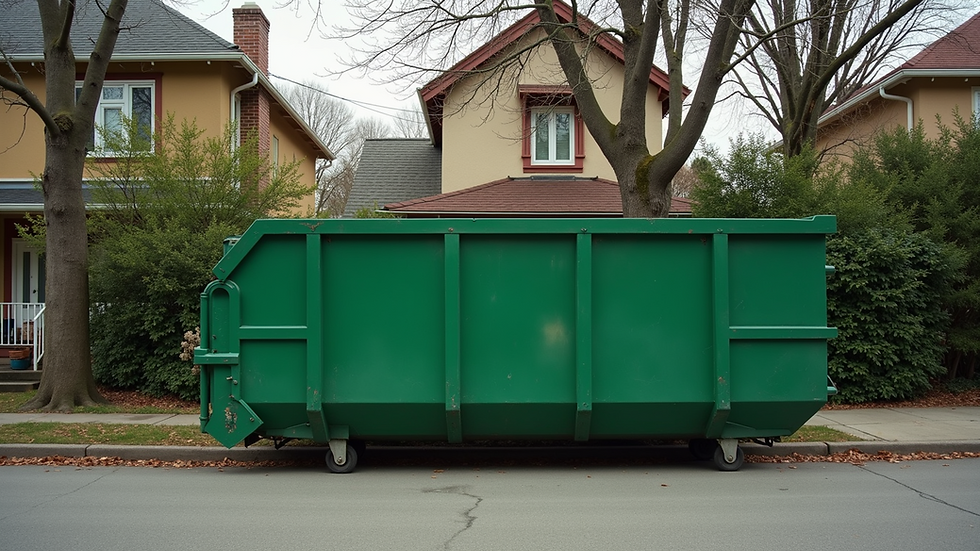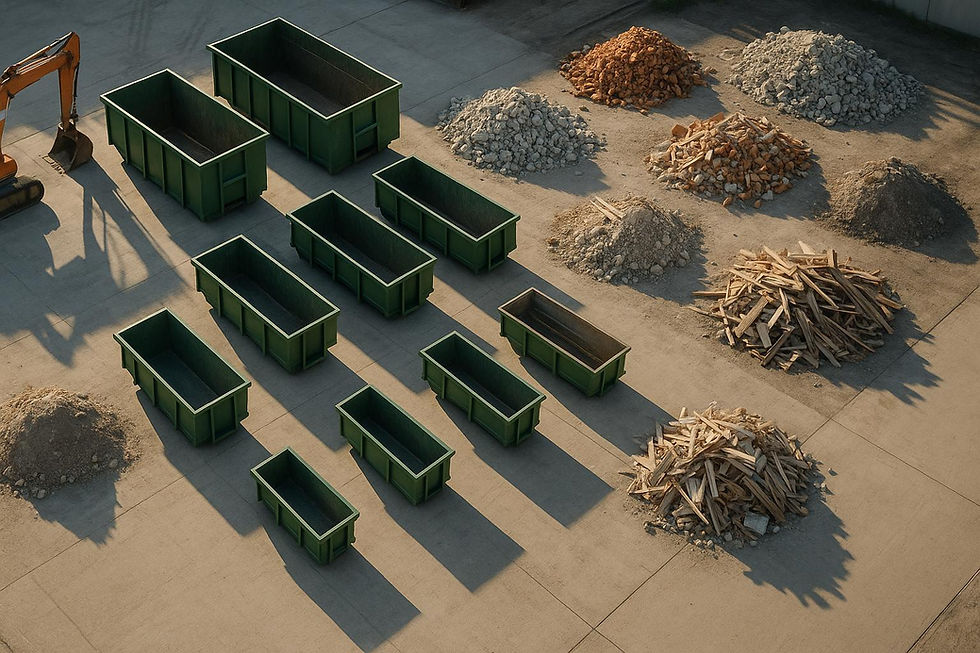
5 Eco-Friendly Ways to Handle Construction Waste
- Gregory Cunningham
- Mar 19
- 4 min read
Updated: May 22
Construction projects generate massive waste, but managing it sustainably can save money, reduce landfill use, and protect resources. Here's a quick guide to eco-friendly waste handling:
- Sort and Recycle Materials: Recycle metals, concrete, wood, and more. Saves costs and reduces landfill waste.
- Donate Usable Materials: Give cabinets, sinks, doors, and fixtures a second life through donation centers like Habitat for Humanity ReStores.
- Choose Eco-Friendly Disposal: Work with waste services that focus on recycling and provide waste diversion reports.
- Reuse Materials in New Projects: Repurpose salvaged items like wood, bricks, and steel to cut costs and reduce resource use.
- Reduce Waste During Construction: Plan projects carefully, use prefabricated components, and train staff to minimize waste.
Each method not only benefits the environment but also offers financial advantages. Start small by setting up recycling bins or donating materials, and scale up with better planning and partnerships.
Innovative Approaches to Construction Waste Management
Sort and Recycle Materials
Sorting and recycling materials effectively can significantly reduce both waste and expenses. This approach plays a key role in reducing the environmental impact of construction projects.
Common Recyclable Materials
Construction sites generate a wide range of materials that can be recycled instead of ending up in landfills. For instance, structural steel has a recycling rate of 97%, and concrete is recycled at 95%. Below are some of the main materials you can recycle:
- Metal Components: Steel beams, copper wiring, aluminum siding, and metal roofing.
- Concrete and Masonry: Concrete blocks, bricks, asphalt, and stone.
- Wood Products: Salvaged lumber, plywood, wooden flooring, and trim.
On-Site Recycling Setup
"Having the waste diversion estimates completed upfront allows the person applying for the permit to assess the reasonableness of the expectations in the jurisdiction; the estimated wastes are often based on average ranges, and all projects are unique."
- Stephen Bantillo, Executive Director at Recycling Certification Institute
To ensure efficient recycling on-site, consider these steps:
- Partner with local recycling facilities before starting the project.
- Use clearly labeled containers for different types of materials.
- Place covered bins in easily accessible locations.
- Train workers on proper sorting methods.
- Regularly check bins to avoid contamination.
These practices not only streamline recycling efforts but also help cut costs.
Cost Savings Through Recycling
Recycling construction materials isn't just good for the planet - it’s also good for your budget. Savings come from reduced landfill fees, lower transportation costs, and even potential rebates from recycling centers.
To get the most out of recycling, construction companies should regularly analyze waste and build relationships with local recycling facilities. While the initial investment in recycling setups might seem higher, the long-term financial advantages often outweigh the costs. This is especially important given that construction waste makes up about 30% of landfill space in the U.S..
Donate Usable Materials
Donating usable construction materials is a great way to give them a second life and help your community. Instead of tossing items in the trash, consider donating them to reduce waste and make a positive impact.
What to Donate
Here’s a list of items that are typically accepted for donation, as long as they’re clean, undamaged, and ready for use:
- Kitchen and Bath: Cabinets with working drawers and doors, sinks, toilets, and bathtubs in good condition (no chips or stains).
- Structural Materials: Internal and external doors, windows, and lumber (at least 4 feet long).
- Fixtures: Light fixtures that work, as well as complete door handles and cabinet hardware.
- Flooring: Tiles and wood flooring that are clean and free of nails or screws.
Make sure all items are free of water damage, mold, or rot, and include all necessary components.
Where to Donate
If you have materials that are still usable after a renovation, donation centers like Habitat for Humanity ReStores are a great option. These locations accept a wide range of building materials and are found throughout the United States.
Here’s how to donate:
- Find a Location: Use your ZIP code to locate the nearest ReStore.
- Check Accepted Items: Contact them to confirm they’ll accept your materials.
- Plan Transportation: Many ReStores offer pickup services for larger donations.
Tax Benefits
Donating materials can also come with tax perks if you document everything properly. Here’s a quick guide:
Donation Value | Requirements | Documentation Needed |
Under $500 | Standard deduction | Donation receipt |
$500 - $5,000 | IRS Form 8283 Section A | Donation receipt and photos |
Over $5,000 | IRS Form 8283 Section B | Receipt, photos, and a qualified appraisal |
To make the most of these benefits:
- Take clear photos of the items before donating.
- Request detailed receipts from the organization.
- Keep records of the fair market value for each item.
Choose Eco-Friendly Disposal
Opting for an eco-conscious disposal service can help reduce your project's impact on the environment. The right provider ensures materials are diverted from landfills while staying compliant with local laws.
What to Look For
When choosing a waste management service, focus on these key aspects:
- Recycling Programs: Prioritize services that sort and recycle materials instead of defaulting to landfills.
- Documentation: Check if they provide waste diversion reports and maintain compliance records.
- Specialized Equipment: Look for clean-load dumpsters tailored for specific material types.
- Sorting Abilities: Confirm their capacity to separate recyclable items from general waste.
For better recycling efficiency, fill dumpsters with similar materials. This reduces processing time and improves outcomes.
Dump & Go Services
Dump & Go offers waste management solutions designed with the environment in mind, particularly for construction projects. Here's a snapshot of their services:
Service Type | Features | Environmental Benefits |
Residential Dumpsters | 15-20 yard capacity, quick delivery | Supports material recycling |
Commercial Solutions | Flexible scheduling, various sizes | Minimizes landfill usage |
Specialized Removal | Handles demolition and agricultural waste | Promotes resource recovery |
With 24/7 availability and fully insured staff, Dump & Go ensures smooth waste management tailored to your project.
Tips for Working with Green Services
Combine these strategies with early waste-sorting efforts to maximize sustainability:
1. Plan Ahead
Share your project's needs upfront. This helps the service provide the right containers for different materials, boosting recycling efficiency.
2. Train Your Team
Educate your crew on how to properly separate materials. Proper sorting increases the amount of waste that can be recycled or reused instead of ending up in landfills.
3. Track Your Efforts
Monitor waste metrics to identify areas for improvement. This data not only helps refine your disposal strategy but also showcases your commitment to sustainable practices.
Reuse Materials in New Projects
Reusing materials is a smart way to reduce waste and save resources in construction. The industry consumes over 75% of the Earth's natural resources, so finding ways to repurpose materials is crucial. By reusing materials, you can lower costs and minimize environmental damage, making it a practical addition to other eco-friendly practices.
Project Ideas
Repurposing salvaged materials can lead to creative and functional results. For instance, at Georgia Tech's Kendeda Building, materials like slate shingles, storm-damaged trees, and heart pine joists were transformed into showers, benches, and staircase treads. These examples highlight how discarded items can find new life in both structural and decorative roles.
How Reusing Saves Money
Alyssa from Pure Living for Life shared her cost-saving successes: she bought fiberglass batt insulation for $50 (usually over $500), five double-pane vinyl windows for $200 (typically over $1,000), and 2,000 bricks for just $75 (normally nearly $4,700). These savings show how reusing materials can significantly cut expenses.
Tips for Selecting and Preparing Materials
To get the most out of reused materials, consider these steps:
- Safety First: Check materials for structural integrity and any signs of damage or wear.
- Processing Materials:
- Clean and sort by type.
- Remove fasteners, adhesives, or contaminants.
- Store materials in a dry, secure space.
- Keep records of material specifications for future use.
- Focus on Proven Materials: Items like steel (with about 25% already recycled in construction), hardwood flooring, solid doors, architectural features, and light fixtures are great options. When installing reused materials, use mechanical fasteners instead of adhesives to preserve their condition for potential reuse later.
Reduce Waste During Construction
Cutting down on construction waste starts with smart planning and practical techniques. Beyond recycling and donating, managing waste effectively at the job site plays a big role. Studies show that well-organized projects lead to fewer errors and less waste.
Project Planning
The foundation of waste reduction lies in solid project planning. Before construction kicks off, project managers need to create strategies to limit excess materials and waste.
"As a project manager, you're tasked with building a plan before diving into the job. When the project is organized properly, fewer mistakes are made, which results in less waste on your construction site".
Some key steps in the planning phase include:
- Using software to calculate material needs accurately
- Setting up digital tools to track waste
- Regularly checking inventory levels
- Creating on-site stations for reuse and recycling
Incorporating modern building techniques, like prefabrication, can also significantly reduce waste.
Pre-Made Components
Prefabrication methods can cut waste by as much as 90% compared to traditional construction, especially for materials like timber, cardboard, plastics, and concrete.
Take the Baptist Health Care campus project in Pensacola, Florida, for example. This 57-acre development utilized prefabricated components such as:
- Steel structural elements
- Precast panels for the building envelope
- Interior wall partitions
- Preassembled patient toilet pods
- Mechanical, electrical, and plumbing systems
The project was completed in just 48 months, showcasing both efficiency and reduced waste.
"Prefabricated building elements can help shorten construction schedules, improve quality control and provide safer working conditions, making them an attractive option".
Staff Training
A well-trained workforce is essential for effective waste management. Training programs give workers the practical skills they need to implement waste reduction strategies.
Training Component | Purpose | Implementation Method |
Waste Segregation | Properly sort materials | On-site demonstrations |
Recycling Practices | Maximize material recovery | Interactive workshops |
Disposal Methods | Ensure compliance | Regular toolbox talks |
Progress Monitoring | Track waste reduction goals | Digital tracking systems |
Some contractors also use performance-based compensation systems, where subcontractors are fully paid only after proving they’ve followed proper waste management practices.
Next Steps
Construction and demolition (C&D) materials account for a massive 70% to 95% of discarded materials at construction sites. Managing this waste effectively is critical for reducing environmental impact.
Here’s how to approach waste management based on your project size:
Project Size | Primary Focus | Initial Steps |
Small Residential | Reduce Waste | Set up sorting stations; contact local recyclers |
Medium Commercial | Recover Materials | Use a tracking system; arrange separate dumpsters |
Large Development | Full Program Setup | Build recycling partnerships; plan waste reduction |
The numbers speak for themselves: Over 95% of concrete and asphalt concrete waste was recovered in 2018, showing the potential for better waste practices.
"Salvaging C&D materials that are still valuable is the most effective way to save money and protect our planet and its natural resources." - Hometown Demolition
Here are a few actionable steps to boost sustainability:
- Use a digital tracking system to monitor waste reduction and meet LEED certification goals.
- Set up designated collection areas to sort materials properly.
- Reach out to Dump & Go for expert waste management services, including dumpster rentals and material transport.
Need reliable solutions? Dump & Go offers 15-to-20-yard dumpsters and fast delivery services tailored to local regulations. Take these steps to make your project as efficient and eco-friendly as possible.



Comments